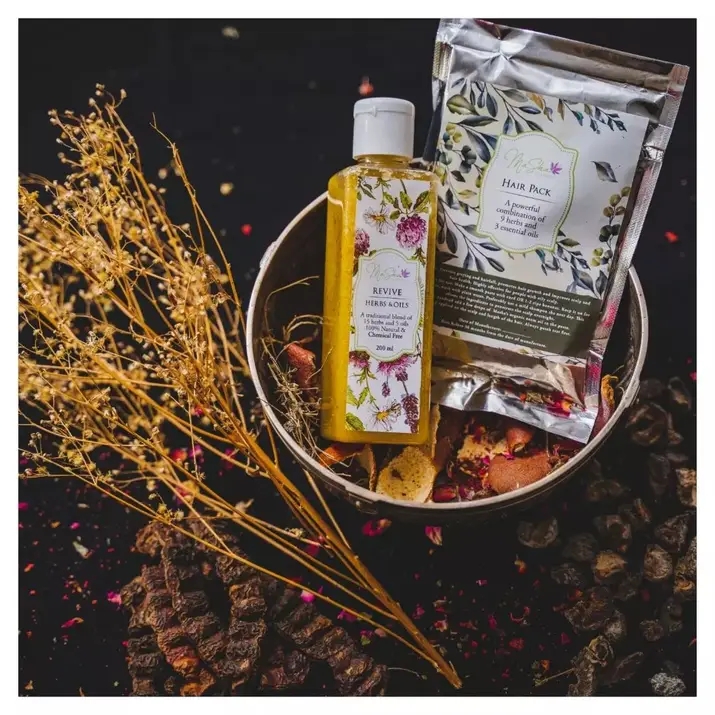
Malika, a successful lawyer from Kashmir decided to follow her passion of crafting organic, herbal beauty products and thus brand Masha by Malika was born. Let’s know more about the lawyer -cum -entrepreneur, Malika Ghalib Shah.
Born and brought up in the beautiful valleys of Rajbagh in Srinagar, 31 year old Malika had always been inclined towards academics. She was an LLB topper and a gold medallist in Kashmir University and then pursued her LLM degree from University College, London through the prestigious Chevening Scholarship. Malika is also a recipient of the Young India Fellowship (YIF) programme at Ashoka University. While studying at YIF she got the opportunity to interact with people from all over India and learn about their cultures, lifestyles and even traditional beauty recipes. Malika fondly recalls a roommate coming from a village in south India who had shared a few of her traditional south Indian hair oil recipes with her. Malika says she uses them in her products, Masha by Malika
Kashmir; more than a paradise
Kashmir is no doubt a wonderful tourist destination with its snow-capped mountains, scenic lakes and lush green gardens but it is also abundant with diverse flora and fauna. This Heaven on earth, grows herbs (gautheer roohun, handoon), trees (sandalwood), flowers (rose, lotus, marigold, jasmine, sunflower, lavender) fruits (apples, peach, cherries, olives, papaya, pomegranate) dry fruits (walnuts, almonds, cashews, apricots) spices (turmeric, saffron) and much more. Malika uses many of those homegrown herbs, fruits, flowers etc. in her beauty products and while doing so encourages Kashmiri women to cultivate native plants. Organic raw materual like coconuts (that doesn’t grow in Kashmir) is also sourced from across the country to prepare her products.
Fascinated by dadima’s beauty!
While growing up, Malika was intrigued by the beauty of Kashmiri women, moreso by the beauty of women of previous generations, like those of her grandmothers age. They never used beauty products like creams, shampoos, conditioners (as we do now) and yet had flawless skin and maintained their beautiful, thick and long hair very well. Nevertheless, the cool, soothibg climate, genetics and pollution- free environment are also responsible for their beautiful, silken complexions but there was more to it, she thought. Malika gradually learnt that earlier women used malai and oils instead of creams and lotions to moisturise their skin and exfoliated their skin with powdered almonds and walnuts. They also added pure saffron to face packs which gave that pink hue and youthful glow to their skin. Homemade, herbal hair oils made their hair thick, dark and strong.
With busy lives and tight schedules, no one has the time to formulate oils and moisturisers at home. We are bound to use bottled beauty products for our daily requirements. But we have to make sure what we are using is made from pure and natural ingredients. And Malika’s products are exactly that; they are harmless as they are made from organic, natural ingredients, free from chemicals, artificial colours and fragrances and prepared using traditional techniques and recipes.
The story behind MaSha by Malika
After completing her Masters degree in Law from London, when Malika returned to her hometown.she had some free time on hand. Malika says that she is very creative and a creative person is always edgy and vying to try something new and interesting in his/ her spare time. It was the same with her. She somehow got her hands onto her grandmothers heirloom beauty recipes and formulated some skin oils which did wonders for her complexion. She went on to prepare a few more handmade products with locally available resources for family and friends. These included a Kashmir soap and an illuminating face pack. She used rose petals pure saffron, pure Kashmiri honey, almond oil, goat milk in those products. Those who used them just loved her products. This encouraged Malika to advertise and sell them and so she put ads on social media. She was surprised when she got an overwhelming response for her homemade beauty products. By then Malika registered the brand under the name Masha by Malika in 2019. After some time as the demand for her products increased, she started manufacturing the products in a small factory. Malika employs local women who work under her supervision. That way she also provides employment to women belonging to economically weak backgrounds which helps them become financially independent, strong women.
Malika also feels blessed to have a family like hers; they have always supported her even when she decided to give her Law career a backseat and turn her hobby (of making beauty products) into a business. They believe that if a person is honest, dedicated and courageous he/she can be successful in any field.
Another advantage is that now the goverment of Kashmir is supporting Kashmiri women, by bringing new schemes for the women. So many women in Kashmir are becoming entrepreneurs and starting their own business ventures in the field of fashion or beauty. They are tech- savvy and business- oriented. Malika herself connects with people on social media and ships products throughout India. This is a fantastic means for marketing, because of which products can be delivered to more people and also orders can be obtained.






























